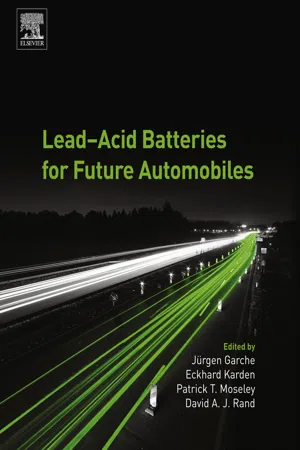
Lead-Acid Batteries for Future Automobiles
- 706 pages
- English
- ePUB (mobile friendly)
- Available on iOS & Android
Lead-Acid Batteries for Future Automobiles
About this book
Lead-Acid Batteries for Future Automobiles provides an overview on the innovations that were recently introduced in automotive lead-acid batteries and other aspects of current research. Innovative concepts are presented, some of which aim to make lead-acid technology a candidate for higher levels of powertrain hybridization, namely 48-volt mild or high-volt full hybrids.Lead-acid batteries continue to dominate the market as storage devices for automotive starting and power supply systems, but are facing competition from alternative storage technologies and being challenged by new application requirements, particularly related to new electric vehicle functions and powertrain electrification.- Presents an overview of development trends for future automobiles and the demands that they place on the battery- Describes how to adapt LABs for use in micro and mild hybrid EVs via collector construction and materials, via carbon additives, via new cell construction (bipolar), and via LAB hybrids with Li-ion and supercap systems- System integration of LABs into vehicle power-supply and hybridization concepts- Short description of competitive battery technologies
Frequently asked questions
- Essential is ideal for learners and professionals who enjoy exploring a wide range of subjects. Access the Essential Library with 800,000+ trusted titles and best-sellers across business, personal growth, and the humanities. Includes unlimited reading time and Standard Read Aloud voice.
- Complete: Perfect for advanced learners and researchers needing full, unrestricted access. Unlock 1.4M+ books across hundreds of subjects, including academic and specialized titles. The Complete Plan also includes advanced features like Premium Read Aloud and Research Assistant.
Please note we cannot support devices running on iOS 13 and Android 7 or earlier. Learn more about using the app.
Information
Development trends for future automobiles and their demand on the battery
Abstract
Keywords
1.1. Lead–acid batteries in automobiles: still good enough?
Table of contents
- Cover image
- Title page
- Table of Contents
- Copyright
- List of Contributors
- About the Editors
- Preface
- Abbreviations
- Part 1. Overview
- Part 2. Battery Technology
- Part 3. Application Technology
- Part 4. Product Life Cycle
- Part 5. Outlook
- Glossary
- Index